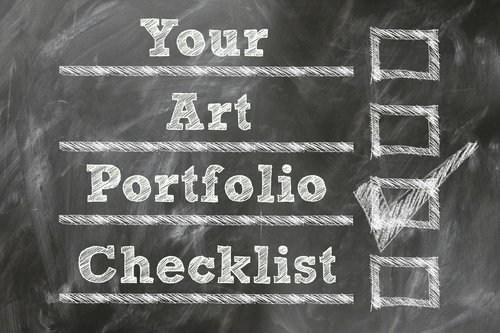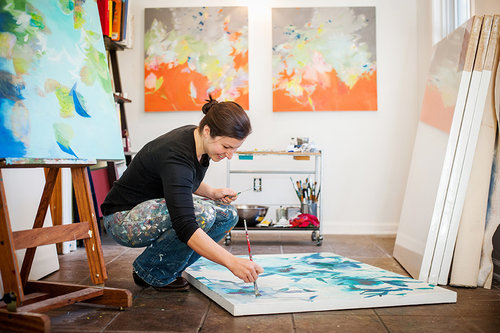by Carolyn Edlund
How to select and assemble your best possible portfolio, and take photos necessary for professional presentation and effective marketing.

If you want to promote and sell your art, you will need a body of work that makes sense and connects well with your chosen audience. And, you will need photos that show your art to its best advantage. These days, many people will never view your portfolio in person – they must rely on digital images, which makes this task even more important.
Your goal may be to get juried into exhibitions, fairs or competitions, win awards, or sell your work. You might want to attract press attention or create marketing collateral. Images are pieces of visual information that share your technique, style and vision, and tell about you as the artist. The more professionally you present yourself and your art, the more seriously you will be taken. And those photographs will share more than just your work – they will go much further.
Your Body of Work
Your body of work itself should be cohesive, in a signature style that is distinctive and memorable. To make impact, it needs to be robust enough to make a statement. I like to see at least a dozen pieces of work by an artist if possible, to get a clear idea of their vision and direction.
If your portfolio is too large, it can become overwhelming and should be pared down to a palatable size. I always recommend that artists select their very best work for their portfolio presentation, carefully evaluating and pulling out pieces that don’t make the cut. I like to see a presentation that reflects your current work and the direction you are going – looking forward, not back.
Portfolio Photographs
When portfolio photos are taken, it’s best to work with a professional photographer who has experiencing shooting art. If that is not possible, you must become practiced enough to take excellent shots of your own work. When you do so, make sure none of the following problems are evident in your photos:
- Poor lighting, glare or hotspots
- Inappropriate backgrounds
- Over or under-exposure
- Focus problems
- Color issues
Straightforward “jury shots” of your work are just one of several types of images you can use to help the viewer experience your art more fully. Additionally, you may want to use the following to enhance your presentation:
Detail Shots
Close-up photographs can share texture, fine detail, and complexity. They may reveal “hidden” elements or highlight the expertise in your technique. They help the viewer gain a greater understanding and appreciation of what you do.
In Situ Photos
Art that is shown displayed in a setting can bring it to life for the viewer. It clearly shows scale and the impact your work has in a room. The photo may show wearable art or jewelry on a person to give an idea of how it can be worn. Or, it might suggest to a collector the type of space that is suitable for your art.
In-Progress Photos
These useful shots build anticipation as work is created before the viewer’s eyes. Many artists report that they have sold work through social media platforms after sharing in-progress photos detailing every step. These photos also help to show the complexity of your work, especially if you have an unusual medium or technique. Videos are also wonderful vehicles to show work in progress.

Painter Elisa Sheehan in her studio.
Studio Shots
As an artist, you are fascinating to most people. Inviting them to virtually step into your studio through the use of photos can be a wonderful way to share your work space, talk about inspiration and your process, and tell your artist story. When you appear in studio photos, you become memorable. Collectors often want to know the artist, and this helps introduce you as the creative behind the work.
Installation or Gallery Photos
Your artwork displayed in a gallery or installed in a corporate or other setting builds credibility and reinforces your CV with visuals. Context is important. Photos of your work in this type of environment may suggest that your work is “gallery worthy” or may increase perceived value.
Booth Shots
Applying to fairs or festivals? Most shows require that a booth photo be submitted with your application. It pays to have an excellent photo taken that enhances your display and shows off your art. At times, photographers will walk shows offering these services, and you might want to take advantage of that. Or, you can set up your booth at home, with controlled lighting and no distractions. Make your booth look like a gallery – and don’t show signage, since most show applications require that you jury anonymously.
Press Photos and Media Kits
Reporters, writers and bloggers are always looking for material, and let’s face it – artists are interesting. If you have photographs available in a high-resolution format ready for print, you will be able to provide these for publications. Online publishing requires low-resolution images.
Media kits are presentations that include written information, photographs, your CV, quotes and more. They may be in PDF format to reside on your website or use as email attachments, or they can be printed out as physical collateral. A good media kit can be used for a variety of purposes that present you as a professional and show your art beautifully.
Is your portfolio ready to photograph? Do you have excellent shots and a variety of ways to show your work? How have you used them?



I am a Picasa holdover trying to load photos from a Canon 620 to a laptop to crop and upload but Picasa is too complicated for me. Is there a simpler process so I can upload quickly and get back to painting.
Thanks
Carolyn, this is excellent advice on an important topic of preparing the art portfolio. I’ll share this on social media.
Thanks, Renee. I’ve always been a bit of a stickler about presentation (and I know you are too!) There is nothing more satisfying than seeing an artist who knows how to use their portfolio to make their work really shine.